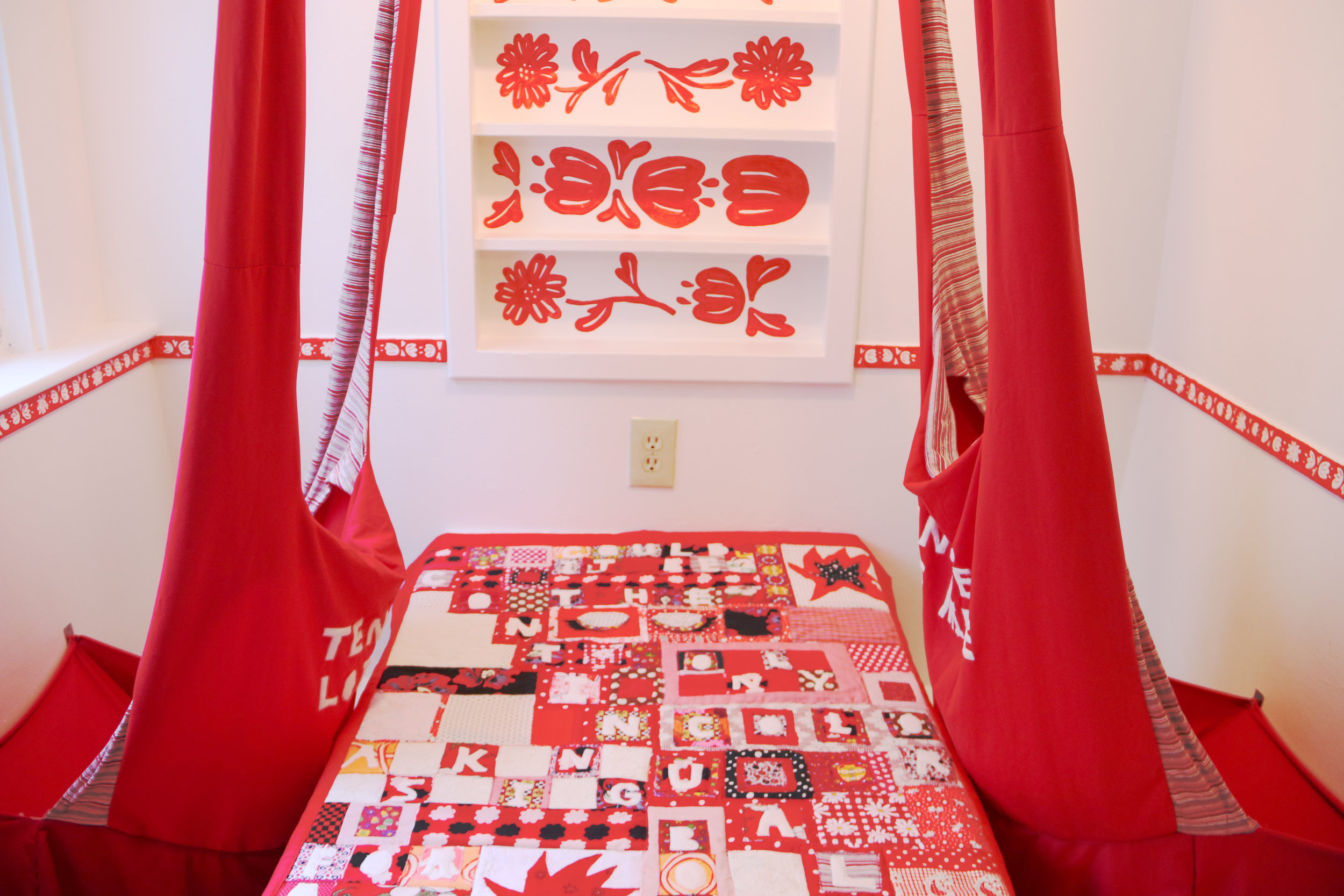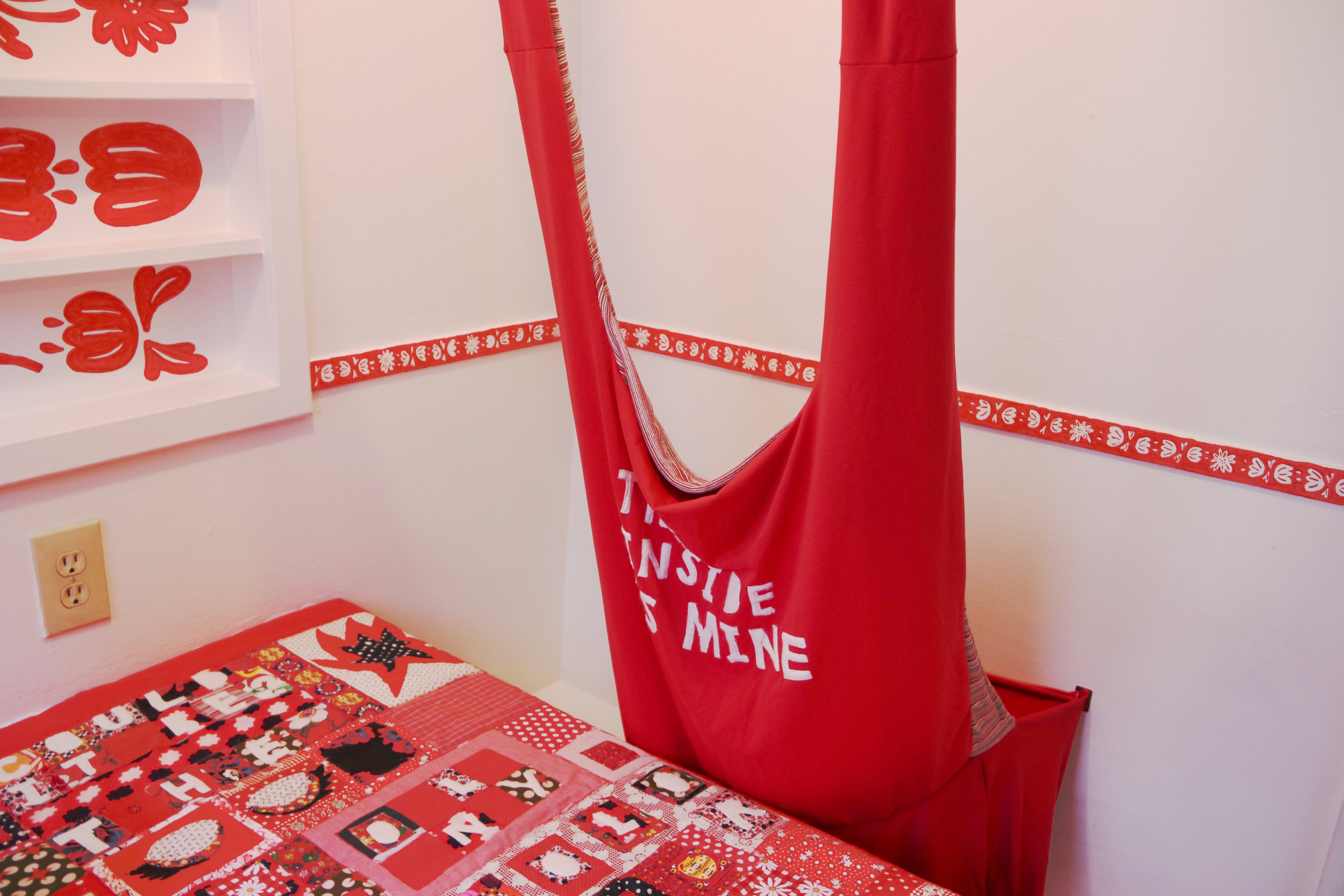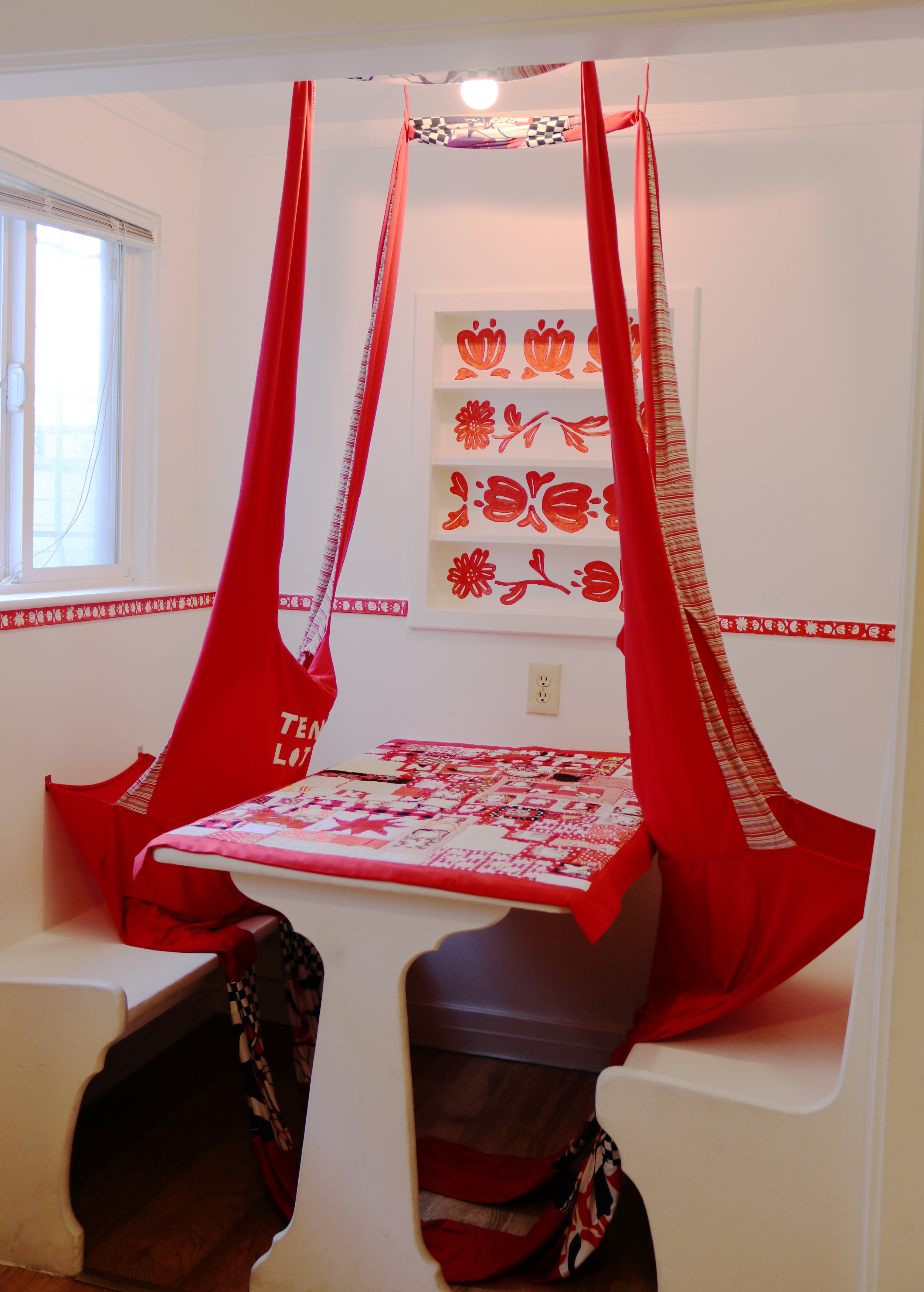Why can’t we speak in gradients: Maya Gulassa and Could it be that red is the only color that is continually asking for a body?
By Camile Messerly
Whenever I’m home my mother asks me if I need an iron; I say no. Truth be told I don’t mind the wrinkles. Creases form naturally as we move and sit; the clothes I wear absorb what I do, form a memory that my skin has pressed onto them. When I pull jeans out of the dryer there is a set of folding lines left along the cuffs, a black linen tank top holds onto a wave of rolls that bounce when I step. Every garment carries a word from my touch and personal body language; my closet and all of our respective closets are like thesauruses.
We step into garments for a number of reasons, more often than not to simply be clothed, to separate as well as to connect ourselves to/from the world and the community. Sometimes we wear a uniform, and even uniforms can hold sentiment. The patterns found in fisherman sweaters were familia: if you were lost at sea you could be identified by your knit. If we’re feeling spry, we may also dress to play. For the fiber-centric artist Maya Gulassa, finding a way to access play and provide a reciprocative gesture to others is key. The way she activates this in her day-to-day life is by dressing in monochromatic looks. Gulassa shared with me a conversation she had with a friend and child psychologist who explained that the way that we as adults access play is often times done through drugs and alcohol, whereas for children, sometimes it can be as simple as dressing up to find their way back into their playful nature.
In her work Gulassa extends not just a hand for us to run through the playground holding, she builds the space for us to participate in. When I stepped into Gulassa’s installation at Nook Gallery in Oakland I was rapt in what felt like a manifestation of the physical intuition we carry with us, both in our personal relationships and the relationships we hold with ourselves. Gulassa came across the title of this show, Could it be that red is the only color that is continually asking for a body? as a question posed by John Berger to John Christie in I Send You This Cadmium Red, a collaboration made through correspondence. Gulassa said that this question struck her; her thought in response to this was “aren’t all colors asking for a body?”
In Gulassa’s previous work she was creating bodies for lots of different colors, developing interactions with each of the colors she had chosen to focus on; red, orange, yellow, pink, blue. By returning to red she created a space for us to share and to consider the color that vulnerability and tenderness can take underneath our skin and radiate out—pause for a minute, think about it when was the last time you felt yourself really blush?
This body of red rested its limbs in Nook Gallery, whose nestled architecture allowed for the artist and us as viewers to truly lean into the work. Located in the kitchen of Lead Curator and Director of Programming, Lukaza Branfman-Verissimo, the site-specificity of the nook is immediately disarming. To fully view this work each visitor was meant to step out of their own shoes and take a seat in the installation’s jersey sleeves and legs while letting your neck be cradled in a mock turtleneck. When fully immersed you would find yourself in an upward surrender stretch. This suit was wrapped and hung around the table from floor to ceiling in one piece. Resting on the table was a quilt that hung just off the edges on which, in crossword-puzzle form, the exhibition’s title was prompted to us again, “Could it be that red is the only color that is continually asking for a body”? On strips of the trim and in-between the shelves, Gulassa painted red and white flowers. The shelves remained empty until just after a Red Party: an event held for people to gather to wear red, eat red, and make a red deposit to the shelves. The red and white flowers decorating the trim of the space mimic the frame of another piece, a small quilt with floral and patterned squares surrounded a section of white panties embroidered to read “I feel red under my skin for you”. This is the only piece made by Gulassa that hints at another person that may or may not be present in the work. I say this because the play at work here requires presentism, this was not an exhibition which allows for a kind of disinterested distance. Instead, it had to be entered, lived.
Gulassa explained to me that she hoped those sitting down in that tender shell would do so with another person. Depending on what seat you took a different emblem was patched across your chest, one read TENDER LOINS, the other read THE INSIDE IS MINE. This was a nod to the character Geryon in Anne Carson’s ‘Autobiography of Red’. He was a mythical winged creature who not only lived in a world of red but he himself was red.
[Geyron] thought about the difference
between outside and inside
Inside is mine, he thought
Red belongs to him, as it does to me, as it does to any individual sitting across from you in this exhibition. Gulassa gave the color red the opportunity to not only be more than an attribute and have a body, she allowed it to have many. Lately, I’ve wondered about the heat that comes from the color red. The heat that churns inside of you and rises up to your skin, the heat that forms when you’re relaxed in the small of your back. How can we and should we share or protect the red that comes from us?
When Gulassa sat down across from me in the Nook she introduced me to a form of color theory that is also known as an alternative form of medicine called chromotherapy or simply color therapy. This is a form of light therapy utilizing colored light to balance the physical, mental, or emotional energy that is lacking in one’s body. Gulassa told me that her interest in this theory comes from Edwin D. Babbit’s text “The Principles of Light and Color”. In this, Babbit makes the claim that the word color has an etymological connection with the word calor (meaning heat), meaning colors were more than just a natural factor or descriptor. He wanted to show people that they themselves had energy and that for instance, when applied through light therapy, red can enrich our blood. Moreover, because red things like cayenne peppers are stimulating to the body, perhaps red itself has a stimulating power.
Since the original publication of Babbit’s work in 1878 many have referred to this work as being a pseudoscience, some may even call it “woo-woo”. However, Gulassa sees Babbit’s theory as scientifically different from other color theories in the way it discusses the energetic field surrounding a color. In one specific case, Babbit used red light to treat a 45-year-old man suffering from complete physical exhaustion and symptoms like pains in the back of the head, loss of appetite, and heart flutterings. After three visits it was reported that he had fully recovered and was moving with an extra bit of vigor and pep to his step.
What could we do with this energy today? In the Nook, we came around a table, where Gulassa reminded us that we are not alone, and even if the other seat may be empty we can find a way to play. For now, Gulassa is shifting her focus from red to return to yellow, a color she holds a strong affection for. She is occasionally giving stick-n-poke tattoos, and is currently an artist in residence at Mutual Stores in Oakland.




